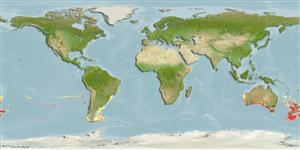Classification / Names
Common names from other countries
Main reference
Size / Weight / Age
Max length : 120 cm TL male/unsexed; (Ref. 1371); 130.0 cm TL (female); common length : 80.0 cm TL male/unsexed; (Ref. 1371); max. published weight: 1.5 kg (Ref. 1371); max. published weight: 1.5 kg; max. reported age: 25 years (Ref. 6390)
Length at first maturity
Lm ?, range 65 - 70 cm
Environment
Marine; brackish; benthopelagic; oceanodromous; depth range 0 - 1000 m (Ref. 26566), usually 200 - 700 m (Ref. 9563)
Climate / Range
Subtropical, preferred 14°C (Ref. 107945); 15°S - 55°S, 111°E - 173°W (Ref. 58452)
Distribution
Short description
Dorsal
spines
(total): 12 - 13;
Dorsal
soft rays
(total): 96-106;
Anal
spines: 0;
Anal
soft rays: 89 - 93;
Vertebrae: 78 - 81. Dorsal surface silvery, with a purple or blue-green tinge; plank and belly silvery; fins darker. Body very elongate and compressed with a tapering tail, dorsal and anal fins confluent with the caudal fin (Ref. 33856).
IUCN Red List Status (Ref. 115185)
Threat to humans
Harmless
Human uses
Fisheries: highly commercial
Tools
Special reports
Download XML
Internet sources
Estimates of some properties based on models
Phylogenetic diversity index
PD50 = 0.5625 many relatives (e.g. carps) 0.5 - 2.0 few relatives (e.g. lungfishes)
Trophic Level
4.5 ±0.2 se; Based on diet studies.
Resilience
Low, minimum population doubling time 4.5 - 14 years (K=0.12-0.2; tm=3-7; tmax=25; Fec = 1,000,000)
Vulnerability
High to very high vulnerability (66 of 100)
Price category
